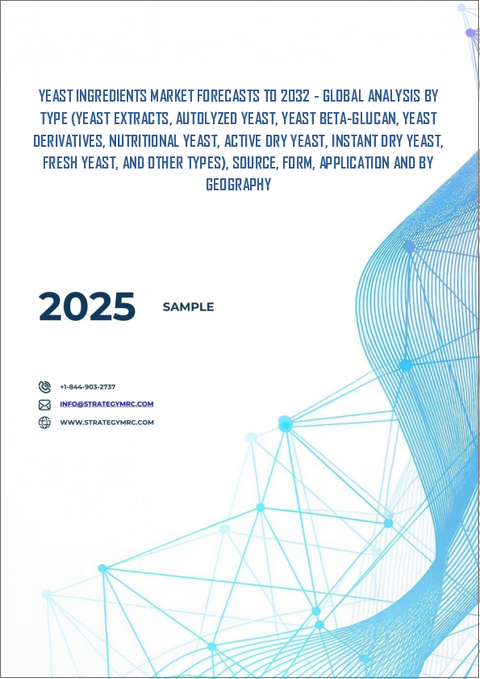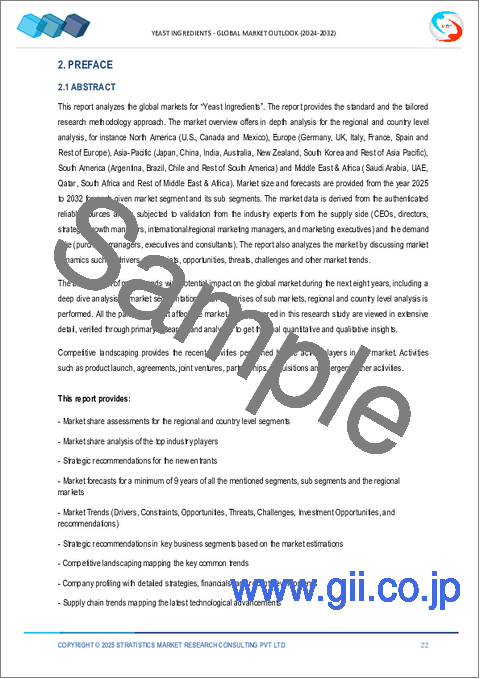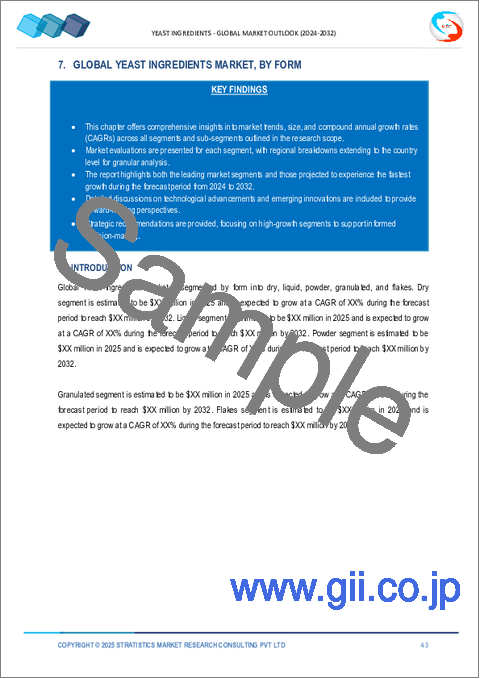|
|
市場調査レポート
商品コード
1734861
酵母材料市場の2032年までの予測:タイプ別、原料別、形態別、用途別、地域別の世界分析Yeast Ingredients Market Forecasts to 2032 - Global Analysis By Type, Source, Form, Application and By Geography |
||||||
カスタマイズ可能
|
|||||||
| 酵母材料市場の2032年までの予測:タイプ別、原料別、形態別、用途別、地域別の世界分析 |
|
出版日: 2025年05月03日
発行: Stratistics Market Research Consulting
ページ情報: 英文 200+ Pages
納期: 2~3営業日
|
全表示
- 概要
- 図表
- 目次
Stratistics MRCによると、世界の酵母材料市場は2025年に34億4,000万米ドルを占め、予測期間中にCAGR 10.4%で成長し、2032年には68億8,000万米ドルに達する見込みです。
酵母材料は酵母細胞に由来する天然物質で、食品や飲食品の風味、栄養、機能性を高めるために使用されます。これらの成分には、酵母エキス、自己溶菌酵母、ベータグルカン、不活性ドライイーストなどが含まれ、うま味、食感の改善、栄養強化などの利点を提供します。加工食品、スープ、ソース、ベーカリー製品に一般的に使用されるイースト原料は、人工添加物や風味増強剤のクリーンラベル代替品としての役割も果たします。
クリーンラベル製品に対する需要の高まり
消費者はますます自然で無添加の食品を求めるようになっており、クリーンラベルのイースト成分の需要を牽引しています。健康志向のバイヤーは、人工保存料や添加物を最小限に抑えた透明な表示を好みます。酵母素材は、クリーンラベルのトレンドに沿いながら、風味強化や栄養価といった機能的な利点を提供します。アレルギーや食事制限の増加により、天然酵母ベースのソリューションへの関心がさらに高まっています。研究開発メーカーは、栄養プロファイルを改善したイースト原料を開発するために研究投資を行っています。
変動する原料価格
酵母材料の生産に使用される原材料のコストは非常に変動しやすく、メーカーの利益率に影響を与えます。価格変動は季節的変化、気候の影響、農業サプライチェーンの混乱などの要因に起因します。イーストの生産は糖蜜や砂糖などの原材料に依存しているため、世界の農産物市場の変動はコストに影響します。経済の不安定性や貿易政策もまた、この業界における予測不可能な価格決定力学の一因となっています。メーカーは効率的な調達や長期サプライヤー契約などの戦略を採用し、価格変動を緩和する必要があります。
酵母生産における技術の進歩
発酵技術とバイオテクノロジーの革新は酵母材料生産に革命をもたらしています。高度な加工技術により、メーカーは酵母の抽出効率と純度を高めることができます。バイオテクノロジーによる酵母株の開発は機能性を向上させ、様々な産業への応用を拡大します。酵母生産施設における自動化は一貫性、拡張性、および費用対効果を高めます。代替原料や持続可能な生産方法の調査が業界の成長を支えています。
酵母製品の限られた保存期間
酵母ベースの原料は劣化しやすく、保存期間や保存の柔軟性が制限されます。湿気、温度変化、微生物汚染などの環境条件にさらされると腐敗が促進されます。メーカーは、自然の特性を損なうことなく製品の安定性を維持するという課題に直面しています。パッケージングと保存技術における革新は、機能性を保持しながら保存期間を延長することを目指しています。イースト製品の腐敗しやすさは流通ロジスティクスに影響し、効率的な在庫管理が必要となります。
COVID-19の影響
COVID-19のパンデミックは酵母材料市場のサプライチェーンと生産を混乱させ、入手可能性と価格に影響を与えました。食品業界の操業停止は当初需要を鈍化させたが、その後ホームベーカリーやパッケージ食品の増加がイーストの消費を押し上げました。製造業者は原料調達とロジスティクスの制限による課題に直面しました。パンデミック後の栄養および機能性成分に対する意識の高まりが市場の回復を促しました。健康志向の消費者動向の中で、クリーンラベルの免疫サポート酵母製品に対する需要が拡大しました。
酵母エキスセグメントは予測期間中最大となる見込み
酵母エキスセグメントは、食品、飲食品、医薬品用途での広範な使用により、予測期間中最大の市場シェアを占めると予想されます。酵母エキスは風味を強化し、食感を改善し、栄養的な利点を提供するため、製造業者の間で人気があります。植物ベースでうま味に富んだフレーバー・ソリューションの需要が増加しており、市場成長の原動力となっています。消費者は合成添加物に代わる天然素材を求めており、酵母エキスの需要をさらに押し上げています。
予測期間中、飲食品分野が最も高いCAGRが見込まれる
予測期間中、天然成分や機能性成分に対する消費者需要の高まりにより、飲食品分野が最も高い成長率を示すと予測されます。酵母ベースの原料は、加工食品や飲食品の風味、食感、栄養プロファイルを向上させる。クリーンラベルの動きと天然調味料への嗜好が、料理用製剤における酵母エキスの使用を増加させています。酵母ベースの栄養素に関連する健康上の利点は、栄養に敏感な消費者にアピールします。
最大シェアの地域:
予測期間中、アジア太平洋地域は飲食品産業の力強い成長により最大の市場シェアを占めると予想されます。人口の増加、都市化、天然成分に対する消費者の嗜好が酵母ベースの製品に対する需要を促進しています。中国、インド、日本などの国々では、酵母生産と食品イノベーションへの投資が増加しています。原材料の入手可能性とコスト効率の高い製造が業界の拡大を支えています。
CAGRが最も高い地域:
予測期間中、北米地域が最も高いCAGRを示すと予想されるが、これはクリーンラベルおよび機能性食品素材に対する需要の高まりによるものです。米国とカナダの消費者は自然で健康をサポートする製品を優先しており、イースト菌成分の採用が増加しています。植物ベースおよび発酵ベースの食品カテゴリーの拡大が業界の成長を促進します。技術の進歩とバイオテクノロジーへの投資により酵母材料のイノベーションが促進されます。持続可能な食品生産に対する規制支援が市場拡大を促進します。
無料のカスタマイズサービス:
本レポートをご購読のお客様には、以下の無料カスタマイズオプションのいずれかをご利用いただけます:
- 企業プロファイル
- 追加市場プレイヤーの包括的プロファイリング(3社まで)
- 主要企業のSWOT分析(3社まで)
- 地域セグメンテーション
- 顧客の関心に応じた主要国の市場推計・予測・CAGR(注:フィージビリティチェックによる)
- 競合ベンチマーキング
- 製品ポートフォリオ、地理的プレゼンス、戦略的提携に基づく主要企業のベンチマーキング
目次
第1章 エグゼクティブサマリー
第2章 序文
- 概要
- ステークホルダー
- 調査範囲
- 調査手法
- データマイニング
- データ分析
- データ検証
- 調査アプローチ
- 調査資料
- 1次調査資料
- 2次調査情報源
- 前提条件
第3章 市場動向分析
- 促進要因
- 抑制要因
- 機会
- 脅威
- 用途分析
- 新興市場
- COVID-19の影響
第4章 ポーターのファイブフォース分析
- 供給企業の交渉力
- 買い手の交渉力
- 代替品の脅威
- 新規参入業者の脅威
- 競争企業間の敵対関係
第5章 世界の酵母材料市場:タイプ別
- 酵母エキス
- 自己消化酵母
- 酵母ベータグルカン
- 酵母由来製品
- 栄養酵母
- ドライイースト
- インスタントドライイースト
- 生酵母
- その他のタイプ
第6章 世界の酵母材料市場:原料別
- パン酵母
- ビール酵母
- トルラ酵母
- その他の原料
第7章 世界の酵母材料市場:形態別
- ドライ
- 液体
- 粉
- 粒状
- フレーク
第8章 世界の酵母材料市場:用途別
- 飲食品
- パン屋・菓子類
- 飲料
- セイボリー食品
- 乳製品と冷凍デザート
- 調理済み食品とインスタント食品
- 動物飼料
- 医薬品および栄養補助食品
- パーソナルケア
- その他の用途
第9章 世界の酵母材料市場:地域別
- 北米
- 米国
- カナダ
- メキシコ
- 欧州
- ドイツ
- 英国
- イタリア
- フランス
- スペイン
- その他欧州
- アジア太平洋
- 日本
- 中国
- インド
- オーストラリア
- ニュージーランド
- 韓国
- その他アジア太平洋地域
- 南米
- アルゼンチン
- ブラジル
- チリ
- その他南米
- 中東・アフリカ
- サウジアラビア
- アラブ首長国連邦
- カタール
- 南アフリカ
- その他中東とアフリカ
第10章 主な発展
- 契約、パートナーシップ、コラボレーション、ジョイントベンチャー
- 買収と合併
- 新製品発売
- 事業拡大
- その他の主要戦略
第11章 企業プロファイリング
- Lesaffre Group
- AB Mauri
- Lallemand Inc.
- Angel Yeast Co., Ltd.
- Kerry Group plc
- DSM N.V.
- Sensient Technologies Corporation
- Biorigin
- Associated British Foods plc(ABF)
- ADM
- Chr. Hansen Holding A/S
- Alltech
- Biospringer
- Ohly
- Leiber GmbH
List of Tables
- Table 1 Global Yeast Ingredients Market Outlook, By Region (2024-2032) ($MN)
- Table 2 Global Yeast Ingredients Market Outlook, By Type (2024-2032) ($MN)
- Table 3 Global Yeast Ingredients Market Outlook, By Yeast Extracts (2024-2032) ($MN)
- Table 4 Global Yeast Ingredients Market Outlook, By Autolyzed Yeast (2024-2032) ($MN)
- Table 5 Global Yeast Ingredients Market Outlook, By Yeast Beta-Glucan (2024-2032) ($MN)
- Table 6 Global Yeast Ingredients Market Outlook, By Yeast Derivatives (2024-2032) ($MN)
- Table 7 Global Yeast Ingredients Market Outlook, By Nutritional Yeast (2024-2032) ($MN)
- Table 8 Global Yeast Ingredients Market Outlook, By Active Dry Yeast (2024-2032) ($MN)
- Table 9 Global Yeast Ingredients Market Outlook, By Instant Dry Yeast (2024-2032) ($MN)
- Table 10 Global Yeast Ingredients Market Outlook, By Fresh Yeast (2024-2032) ($MN)
- Table 11 Global Yeast Ingredients Market Outlook, By Other Types (2024-2032) ($MN)
- Table 12 Global Yeast Ingredients Market Outlook, By Source (2024-2032) ($MN)
- Table 13 Global Yeast Ingredients Market Outlook, By Baker's Yeast (2024-2032) ($MN)
- Table 14 Global Yeast Ingredients Market Outlook, By Brewer's Yeast (2024-2032) ($MN)
- Table 15 Global Yeast Ingredients Market Outlook, By Torula Yeast (2024-2032) ($MN)
- Table 16 Global Yeast Ingredients Market Outlook, By Other Sources (2024-2032) ($MN)
- Table 17 Global Yeast Ingredients Market Outlook, By Form (2024-2032) ($MN)
- Table 18 Global Yeast Ingredients Market Outlook, By Dry (2024-2032) ($MN)
- Table 19 Global Yeast Ingredients Market Outlook, By Liquid (2024-2032) ($MN)
- Table 20 Global Yeast Ingredients Market Outlook, By Powder (2024-2032) ($MN)
- Table 21 Global Yeast Ingredients Market Outlook, By Granulated (2024-2032) ($MN)
- Table 22 Global Yeast Ingredients Market Outlook, By Flakes (2024-2032) ($MN)
- Table 23 Global Yeast Ingredients Market Outlook, By Application (2024-2032) ($MN)
- Table 24 Global Yeast Ingredients Market Outlook, By Food & Beverage (2024-2032) ($MN)
- Table 25 Global Yeast Ingredients Market Outlook, By Bakery and Confectionery (2024-2032) ($MN)
- Table 26 Global Yeast Ingredients Market Outlook, By Beverages (2024-2032) ($MN)
- Table 27 Global Yeast Ingredients Market Outlook, By Savory Foods (2024-2032) ($MN)
- Table 28 Global Yeast Ingredients Market Outlook, By Dairy and Frozen Desserts (2024-2032) ($MN)
- Table 29 Global Yeast Ingredients Market Outlook, By Prepared Meals and Convenience Foods (2024-2032) ($MN)
- Table 30 Global Yeast Ingredients Market Outlook, By Animal Feed (2024-2032) ($MN)
- Table 31 Global Yeast Ingredients Market Outlook, By Pharmaceuticals & Nutraceuticals (2024-2032) ($MN)
- Table 32 Global Yeast Ingredients Market Outlook, By Personal Care (2024-2032) ($MN)
- Table 33 Global Yeast Ingredients Market Outlook, By Other Applications (2024-2032) ($MN)
Note: Tables for North America, Europe, APAC, South America, and Middle East & Africa Regions are also represented in the same manner as above.
According to Stratistics MRC, the Global Yeast Ingredients Market is accounted for $3.44 billion in 2025 and is expected to reach $6.88 billion by 2032 growing at a CAGR of 10.4% during the forecast period. Yeast ingredients are natural substances derived from yeast cells, used to enhance flavor, nutrition, and functionality in food and beverage products. These ingredients include yeast extracts, autolyzed yeast, beta-glucans, and inactive dry yeast, offering benefits such as umami taste, improved texture, and nutritional enrichment. Commonly used in processed foods, soups, sauces, and bakery products, yeast ingredients also serve as clean-label alternatives to artificial additives and flavor enhancers.
Market Dynamics:
Driver:
Rising demand for clean-label products
Consumers are increasingly seeking natural and additive-free food products, driving demand for clean-label yeast ingredients. Health-conscious buyers prefer transparent labeling with minimal artificial preservatives and additives. Yeast ingredients offer functional benefits such as flavor enhancement and nutritional value while aligning with the clean-label trend. The rising prevalence of allergies and dietary restrictions further boosts interest in natural yeast-based solutions. Manufacturers are investing in research to develop yeast ingredients with improved nutritional profiles.
Restraint:
Fluctuating raw material prices
The cost of raw materials used in yeast ingredient production is highly volatile, affecting profit margins for manufacturers. Price fluctuations stem from factors such as seasonal changes, climate impact, and agricultural supply chain disruptions. Since yeast production relies on raw materials like molasses and sugar, any changes in global agricultural markets influence costs. Economic instability and trade policies also contribute to unpredictable pricing dynamics in the industry. Manufacturers must adopt strategies such as efficient sourcing and long-term supplier contracts to mitigate price volatility.
Opportunity:
Technological advancements in yeast production
Innovations in fermentation techniques and biotechnology are revolutionizing yeast ingredient production. Advanced processing technologies enable manufacturers to enhance yeast extraction efficiency and purity. The development of bioengineered yeast strains improves functionality, expanding applications across various industries. Automation in yeast production facilities enhances consistency, scalability, and cost-effectiveness. Research into alternative raw materials and sustainable production methods supports industry growth.
Threat:
Limited shelf life of yeast products
Yeast-based ingredients are prone to degradation, limiting their shelf life and storage flexibility. Exposure to environmental conditions such as moisture, temperature fluctuations, and microbial contamination accelerates spoilage. Manufacturers face challenges in maintaining product stability without compromising natural properties. Innovations in packaging and preservation techniques aim to extend shelf life while retaining functionality. The perishability of yeast products affects distribution logistics, requiring efficient inventory management.
Covid-19 Impact
The COVID-19 pandemic disrupted supply chains and production in the yeast ingredients market, affecting availability and pricing. Food industry lockdowns initially slowed demand, but the rise in home baking and packaged foods later boosted yeast consumption. Manufacturers faced challenges in raw material procurement and logistics due to restrictions. Increased awareness of nutrition and functional ingredients post-pandemic fueled market recovery. The demand for clean-label, immune-supporting yeast products grew amid health-conscious consumer trends.
The yeast extracts segment is expected to be the largest during the forecast period
The yeast extracts segment is expected to account for the largest market share during the forecast period, due to its extensive use in food, beverage, and pharmaceutical applications. Yeast extracts enhance flavour, improve texture, and offer nutritional benefits, making them popular among manufacturers. The demand for plant-based and umami-rich flavouring solutions has increased, driving market growth. Consumers are seeking natural alternatives to synthetic additives, further boosting demand for yeast extracts.
The food & beverage segment is expected to have the highest CAGR during the forecast period
Over the forecast period, the food & beverage segment is predicted to witness the highest growth rate, due to rising consumer demand for natural and functional ingredients. Yeast-based ingredients enhance flavour, texture, and nutritional profiles in processed foods and beverages. The clean-label movement and preference for natural seasonings drive increased use of yeast extracts in culinary formulations. The health benefits associated with yeast-based nutrients appeal to nutrition-conscious consumers.
Region with largest share:
During the forecast period, the Asia Pacific region is expected to hold the largest market share due to its strong food and beverage industry growth. Increasing population, urbanization, and consumer preferences for natural ingredients drive demand for yeast-based products. Countries such as China, India, and Japan witness rising investments in yeast production and food innovation. The availability of raw materials and cost-effective manufacturing supports industry expansion.
Region with highest CAGR:
Over the forecast period, the North America region is anticipated to exhibit the highest CAGR, owing to growing demand for clean-label and functional food ingredients. Consumers in the U.S. and Canada prioritize natural and health-supporting products, increasing yeast ingredient adoption. The expansion of plant-based and fermentation-based food categories fuels industry growth. Technological advancements and investments in biotechnology enhance yeast ingredient innovation. Regulatory support for sustainable food production encourages market expansion.
Key players in the market
Some of the key players profiled in the Yeast Ingredients Market include Lesaffre Group, AB Mauri, Lallemand Inc., Angel Yeast Co., Ltd., Kerry Group plc, DSM N.V., Sensient Technologies Corporation, Biorigin, Associated British Foods plc (ABF), ADM, Chr. Hansen Holding A/S, Alltech, Biospringer, Ohly, and Leiber GmbH.
Key Developments:
In March 2025, Asahi Group wants to expand its international market presence in the food and biotechnology sectors. To achieve this goal, Asahi Group Foods, Ltd, has conducted a contract with the shareholders of Leiber GmbH, a brewer's yeast-related products manufacturing and sales company with global operations, mainly in Europe, to transfer the shares.
In October 2024, Lesaffre announces the acquisition of Altar, a French start-up specializing in Adaptive Laboratory Evolution (ALE). Created in 2017, Altar will complement Lesaffre's existing know-how and technologies to boost the Group's capacity of innovation in fermentation and microorganisms.
Types Covered:
- Yeast Extracts
- Autolyzed Yeast
- Yeast Beta-Glucan
- Yeast Derivatives
- Nutritional Yeast
- Active Dry Yeast
- Instant Dry Yeast
- Fresh Yeast
- Other Types
Sources Covered:
- Baker's Yeast
- Brewer's Yeast
- Torula Yeast
- Other Sources
Forms Covered:
- Dry
- Liquid
- Powder
- Granulated
- Flakes
Applications Covered:
- Food & Beverage
- Animal Feed
- Pharmaceuticals & Nutraceuticals
- Personal Care
- Other Applications
Regions Covered:
- North America
- US
- Canada
- Mexico
- Europe
- Germany
- UK
- Italy
- France
- Spain
- Rest of Europe
- Asia Pacific
- Japan
- China
- India
- Australia
- New Zealand
- South Korea
- Rest of Asia Pacific
- South America
- Argentina
- Brazil
- Chile
- Rest of South America
- Middle East & Africa
- Saudi Arabia
- UAE
- Qatar
- South Africa
- Rest of Middle East & Africa
What our report offers:
- Market share assessments for the regional and country-level segments
- Strategic recommendations for the new entrants
- Covers Market data for the years 2022, 2023, 2024, 2026, and 2030
- Market Trends (Drivers, Constraints, Opportunities, Threats, Challenges, Investment Opportunities, and recommendations)
- Strategic recommendations in key business segments based on the market estimations
- Competitive landscaping mapping the key common trends
- Company profiling with detailed strategies, financials, and recent developments
- Supply chain trends mapping the latest technological advancements
Free Customization Offerings:
All the customers of this report will be entitled to receive one of the following free customization options:
- Company Profiling
- Comprehensive profiling of additional market players (up to 3)
- SWOT Analysis of key players (up to 3)
- Regional Segmentation
- Market estimations, Forecasts and CAGR of any prominent country as per the client's interest (Note: Depends on feasibility check)
- Competitive Benchmarking
- Benchmarking of key players based on product portfolio, geographical presence, and strategic alliances
Table of Contents
1 Executive Summary
2 Preface
- 2.1 Abstract
- 2.2 Stake Holders
- 2.3 Research Scope
- 2.4 Research Methodology
- 2.4.1 Data Mining
- 2.4.2 Data Analysis
- 2.4.3 Data Validation
- 2.4.4 Research Approach
- 2.5 Research Sources
- 2.5.1 Primary Research Sources
- 2.5.2 Secondary Research Sources
- 2.5.3 Assumptions
3 Market Trend Analysis
- 3.1 Introduction
- 3.2 Drivers
- 3.3 Restraints
- 3.4 Opportunities
- 3.5 Threats
- 3.6 Application Analysis
- 3.7 Emerging Markets
- 3.8 Impact of Covid-19
4 Porters Five Force Analysis
- 4.1 Bargaining power of suppliers
- 4.2 Bargaining power of buyers
- 4.3 Threat of substitutes
- 4.4 Threat of new entrants
- 4.5 Competitive rivalry
5 Global Yeast Ingredients Market, By Type
- 5.1 Introduction
- 5.2 Yeast Extracts
- 5.3 Autolyzed Yeast
- 5.4 Yeast Beta-Glucan
- 5.5 Yeast Derivatives
- 5.6 Nutritional Yeast
- 5.7 Active Dry Yeast
- 5.8 Instant Dry Yeast
- 5.9 Fresh Yeast
- 5.10 Other Types
6 Global Yeast Ingredients Market, By Source
- 6.1 Introduction
- 6.2 Baker's Yeast
- 6.3 Brewer's Yeast
- 6.4 Torula Yeast
- 6.5 Other Sources
7 Global Yeast Ingredients Market, By Form
- 7.1 Introduction
- 7.2 Dry
- 7.3 Liquid
- 7.4 Powder
- 7.5 Granulated
- 7.6 Flakes
8 Global Yeast Ingredients Market, By Application
- 8.1 Introduction
- 8.2 Food & Beverage
- 8.2.1 Bakery and Confectionery
- 8.2.2 Beverages
- 8.2.3 Savory Foods
- 8.2.4 Dairy and Frozen Desserts
- 8.2.5 Prepared Meals and Convenience Foods
- 8.3 Animal Feed
- 8.4 Pharmaceuticals & Nutraceuticals
- 8.5 Personal Care
- 8.6 Other Applications
9 Global Yeast Ingredients Market, By Geography
- 9.1 Introduction
- 9.2 North America
- 9.2.1 US
- 9.2.2 Canada
- 9.2.3 Mexico
- 9.3 Europe
- 9.3.1 Germany
- 9.3.2 UK
- 9.3.3 Italy
- 9.3.4 France
- 9.3.5 Spain
- 9.3.6 Rest of Europe
- 9.4 Asia Pacific
- 9.4.1 Japan
- 9.4.2 China
- 9.4.3 India
- 9.4.4 Australia
- 9.4.5 New Zealand
- 9.4.6 South Korea
- 9.4.7 Rest of Asia Pacific
- 9.5 South America
- 9.5.1 Argentina
- 9.5.2 Brazil
- 9.5.3 Chile
- 9.5.4 Rest of South America
- 9.6 Middle East & Africa
- 9.6.1 Saudi Arabia
- 9.6.2 UAE
- 9.6.3 Qatar
- 9.6.4 South Africa
- 9.6.5 Rest of Middle East & Africa
10 Key Developments
- 10.1 Agreements, Partnerships, Collaborations and Joint Ventures
- 10.2 Acquisitions & Mergers
- 10.3 New Product Launch
- 10.4 Expansions
- 10.5 Other Key Strategies
11 Company Profiling
- 11.1 Lesaffre Group
- 11.2 AB Mauri
- 11.3 Lallemand Inc.
- 11.4 Angel Yeast Co., Ltd.
- 11.5 Kerry Group plc
- 11.6 DSM N.V.
- 11.7 Sensient Technologies Corporation
- 11.8 Biorigin
- 11.9 Associated British Foods plc (ABF)
- 11.10 ADM
- 11.11 Chr. Hansen Holding A/S
- 11.12 Alltech
- 11.13 Biospringer
- 11.14 Ohly
- 11.15 Leiber GmbH






